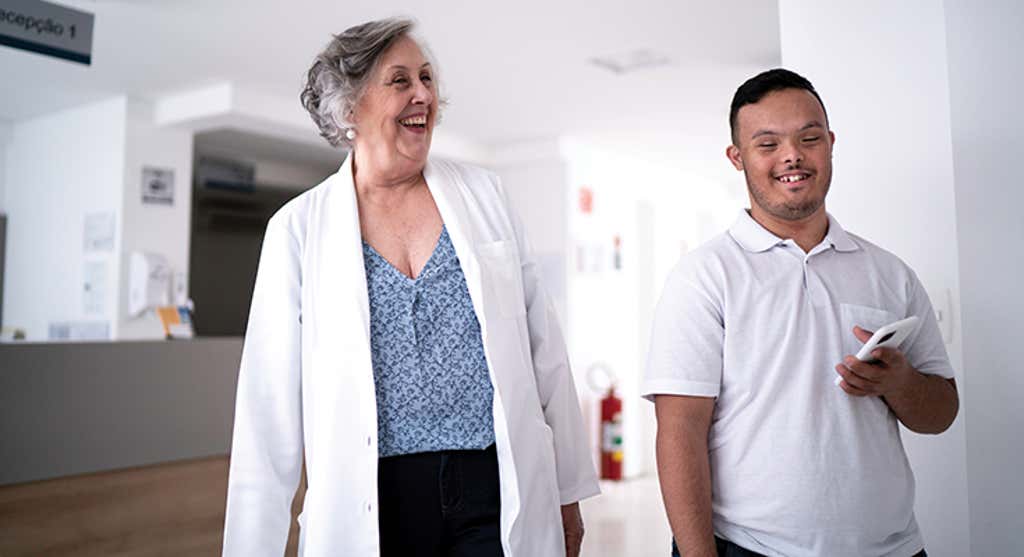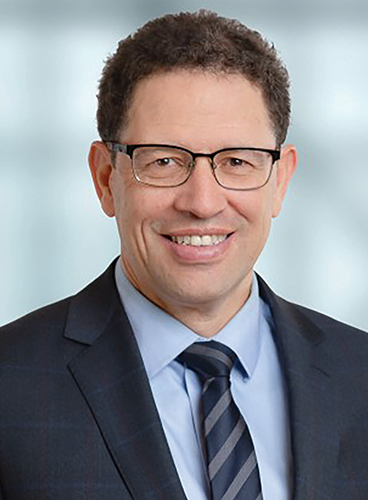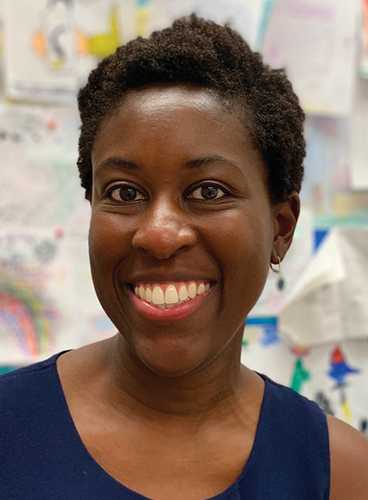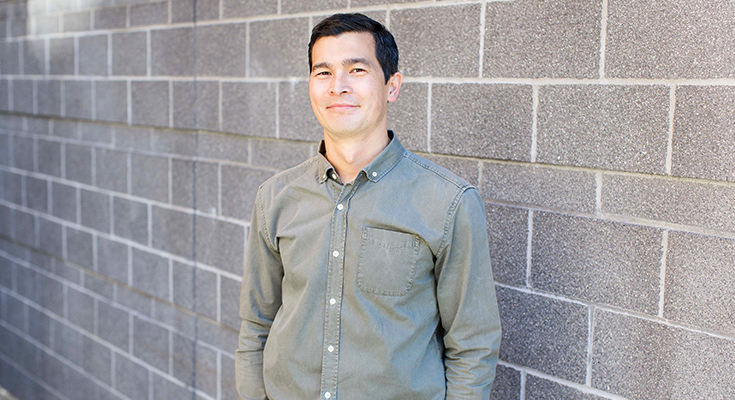
To patients with disabilities, stereotypes can affect care
By Stuart Foxman
When Heidi Janz was born, a doctor gave her mother this advice: “Put her in an institution and pretty much forget that you had her.”
“We don’t do that anymore,” says Janz, who has cerebral palsy and works as an adjunct professor with the University of Alberta’s John Dossetor Health Ethics Centre.
Still, many biases and stereotypes persist about people with disabilities. They manifest in society and can in medical practice too. Ableism is a normalized preference for certain abilities, and a disregard or negative sentiment towards those without those abilities. That can translate into seeing people with disabilities as “less than.”
In the first article, we examined some root causes of biases and ableism, in society and a medical context. That includes the thinking that disabilities are a deviation from the norm and people with disabilities want to be “fixed.” Or that people with disabilities have worse health and quality of life, and that disabilities are a burden on the health care system. And even that some medical interventions aren’t worth it for people with a disability.
Here, we look at how biases can play out. This isn’t about disparities in health care programs or funding for those with disabilities. Those are challenges in themselves, say disability advocates. But there are problems too in everyday interactions, says Janz, who’s active in disability issues and chairs a committee of the Council of Canadians with Disabilities.
For instance, she knows people with disabilities who refuse to enter an ER unless they’re accompanied by an advocate. Why? They fear the doctors will assume they have a low quality of life anyway and will therefore take some treatments off the table.
During the pandemic, Janz had to go to the hospital with pneumonia. Due to COVID restrictions, she couldn’t bring the health care aide who helps her communicate. She says the resident who took her history was very uncomfortable.
Moreover, “Because I have speech issues and I’m in a wheelchair, some people make assumptions about my understanding,” Janz says. “They look at me and automatically don’t think I have a brain that works.”
That can happen anywhere in the community. But it’s in the medical model where she says this becomes a particular issue. “The stakes are a lot higher,” says Janz.
A focus on the “norm”
Dr. Mark Bayley, Medical Director, Brain and Spinal Cord Rehabilitation Program, Toronto Rehabilitation Institute, also sees bias in expectations of what’s a “norm” and assumptions about what the individual desires. It doesn’t just happen with doctors. Dr. Bayley says many parents of children with cerebral palsy are focused on getting them walking. “It looks more ‘normal’ for them,” he says.

So, children go for surgeries and many interventions. But walking takes up so much energy, says Dr. Bayley, that by the time these kids get to where they want to go, they’re exhausted. They would have been better off using a wheelchair, he says.
Too often, he says, patients aren’t asked what’s important to them and what’s normal for them. “We’re the ones labelling them as disabled,” says Dr. Bayley. “They say, ‘This is just me.’”
He sees a flaw in the medical framework of assess, diagnosis and cure. That only works for certain diseases and conditions. “Most things, we assess, diagnose and maybe manage. The model is wrong,” says Dr. Bayley.
For patients with disabilities — or any patients — he says it’s better to just focus on their goals and how to help them get there.
A doctor-knows-best mindset can also get in the way of patient autonomy. That can be especially true when dealing with patients with disabilities, says Dr. Ullanda Niel, a family doctor in Scarborough.
“Sometimes we’re paternalistic in our conversations,” says Dr. Niel, who’s involved in Project ECHO’s guided practice model to build the capacity of health professionals around developmental disabilities.
What does the patient want? Too often, that question is lacking when it comes to patients with disabilities, says Dr. Azadeh Yadollahi, PhD, a rehab scientist at the Toronto Rehabilitation Institute’s KITE Research Institute.
“We don’t always include them in the process of their care. That piece of the partnership is missing. The patient should be at the centre of decision-making,” says Dr. Yadollahi, who also chairs the University Health Network’s Equity, Diversity and Inclusion Committee.
Seen as extra work
Dr. Cathy Craven sees the impact of bias in ways big and small. “I spend an inordinate and inappropriate amount of time advocating for people with mobility impairment to get things like diagnostic tests or disease screenings,” says Dr. Craven, the Medical Lead at the Toronto Rehabilitation Institute’s Spinal Cord Rehabilitation Program.
She’ll send people for anything from an x-ray to a colonoscopy, with a note advising about the need for a lift or assistance with transfers. That often doesn’t happen as it should, even when patients describe how to do it safely. Health care professionals will willfully ignore those instructions, says Dr. Craven. “It’s disheartening.”
Why does it happen? Maybe lack of training is part of it, but Dr. Craven suspects patients with disabilities are seen as extra work, something that throws off a schedule. And that comes back to viewing certain patients as a burden.
She sees a lack of boundaries as another problem. For instance, some doctors might comment on how patients with disabilities choose to spend their time, or ask invasive questions (e.g., how they became disabled). Or doctors might make assumptions (or remarks) about their sex lives and ability to have children.
“In the health care system, there’s also a lot of bias that people with disabilities face. Some people feel individuals with disability are willing guinea pigs and should volunteer their time to be in research, because they have nothing else to do,” says Dr. Craven.
For patients with disabilities — or any patients — it’s better to just focus on their goals and how to help them get there.
Dr. Craven mentions accessibility too. We can think of it in terms of ramps and door openers, “but as a society we need to adopt a broader concept of accessibility and consider the individual and the impact of the environment,” she says. That includes doctors’ offices, many of which are not equipped with a high-low exam table, or a lift that enables a transfer onto the exam table.
Another aspect of accessibility is information. Is it available or explained in a way that makes the most sense for patients? There is no one-size-fits-all. A lack of effort to tailor information and ensure understanding sends another message to patients with a disability: we don’t plan for or revolve around you.
“There are still barriers around communication, where ableism takes over,” says Anthony Frisina of Hamilton, who was born with spina bifida, and who serves as a media representative for the Ontario Disability Coalition.
A matter of respect
Cindy Kabel-Mitchell of Bowmanville says she and her daughter, Karen, have had relatively good experiences with doctors — because they won’t tolerate or return to any who offer anything less. “Karen is hypersensitive to people being respectful to her,” says Kabel-Mitchell.
Her daughter was born with Williams syndrome, a rare genetic disorder that causes, among others, learning and developmental challenges. When Karen was just days old, the doctors told Kabel-Mitchell that people with this condition typically don’t live into their 20s. She was struck by being presented with the worst-case scenario, as opposed to a discussion about how people with disabilities can lead rich lives.
Kabel-Mitchell is VP of Family Alliance Ontario, which offers knowledge, tools and networking opportunities to individuals with disabilities, their families and friends. One goal is to enable inclusion through meaningful participation in society. Karen is now 36 and Kabel-Mitchell calls her, “a gift to the community.”
If she perceives any pity, any feelings from others that her child is a burden, Kabel-Mitchell says her antenna is up. She has sensed that at times when looking for a doctor. Ableist attitudes cross all segments of society. Should doctors be held to a higher standard? “Absolutely, we should be expecting more,” says Kabel-Mitchell.
Kate Welsh of Toronto expected more. She avoided doctors for eight years because, as someone with a disability, she didn’t feel great about the encounters.
When she was younger, doctors automatically addressed her parents instead of her. Later, she says doctors resisted getting her an assistive device. “They were focused on a ‘cure’ rather than supporting me in my life,” says Welsh.
Sometimes, she’ll go in for a routine exam and be asked about her walker. Maybe it’s a matter of making conversation, but Welsh says it just steers things back to her disability, which in that moment is irrelevant. One time, in an appointment, a doctor moved her walker without asking her. It was done innocently, but Welsh starts to panic when she doesn’t have her walker within reach. These incidents add up.
“What does the patient want? Too often, that question is lacking when it comes to patients with disabilities.”
Welsh is now an activist, educator, author and mental health counselor for people with disabilities and chronic illnesses. She facilitates a workshop called “Unpacking Ableism,” and has delivered it to health care professionals and community agencies. In medicine, she says ableism is harmful to both your physical and mental health. Like Welsh, some patients avoid the doctor even though that’s detrimental to health too.
“It creates a vicious cycle,” she says.
Beware of assumptions
Welsh says she’s had doctors who assume she can’t work because she has a disability. Assumptions are dangerous, because they can affect how you view and treat someone.
See someone using a walker or wheelchair? You might jump to a conclusion, says Dr. Craven, that they also have a cognitive impairment. Encounter someone who has trouble expressing themselves verbally? They might comprehend just fine.
Conversely, some people might not take a disability as seriously because of its hidden nature, says Dr. Michael Quon, an internal medicine specialist at Queensway Carleton Hospital and Ottawa Hospital.
Dr. Craven suspects patients with disabilities are seen as extra work, something that throws off a schedule.
He knows that firsthand. In 2015, he was on a cycling trip to Colorado to celebrate the end of his residency, ready to start a new role in Montreal as an internist. A terrible cycling crash caused a traumatic brain injury. Dr. Quon couldn’t work for a year and, when he did return, it was difficult at times to handle the intensity of the job.
His colleagues assumed he was doing better than he felt, as his work was good and his disability was invisible (other than a few scars). “I didn’t look ‘disabled’,” says Dr. Quon, who serves on the Board of the Canadian Association of Physicians with Disabilities.
He wonders if there’s a discomfort within medicine in talking about people’s hardships. Dr. Quon says discussing diagnoses, therapies and medications can overtake crucial conversations to understand the patient experience. He calls his own experience as a patient profound, offering him insight into some of the struggles and difficulties of illness and disability. He deeply valued the times he was treated with empathy and understanding.
Has his injury made him a better doctor? “There’s no doubt. I have a much better awareness of what people are going through,” says Dr. Quon.
Reflect on your beliefs

How do you deal with biases? Not just by eliminating them, but by reflecting on the beliefs you hold and why.
“It’s our job as physicians to check our biases. We can’t assume things about patients,” says Dr. Niel. “Be aware of how you feel about someone you put into a certain box.”
Consider these three responsibilities of clinicians to patients with disabilities, as noted in the AMA Journal of Ethics:
- Develop humility. Your knowledge and understanding of disability is partial. Act accordingly. Learn about the experiences, cultures and histories of disability.
- Communicate better. A lack of patient-centred care and sub-par doctor-patient communication can have significant negative health outcomes.
- Recognize the authority of people with disabilities. They’re experts about their own lives and communities. Listen to them and take them seriously.
As for stereotypes that play off the idea of “normal”? When such a high percentage of the population has a disability, the concept of “normal” loses some meaning.
“I’d challenge the norm perspective. You can’t define one clear cut norm,” says Frisina. He prefers the term “difference of abilities” to “disability.”
We’re all different. Treat each person as an individual and you can’t go wrong. It comes down to something fundamental: know your patient.
“Recognize that everyone has unique needs, and they also have common rights and freedoms,” says Dr. Craven. “Our job is to preserve them while we provide care.”
Watch out for the isms
Prejudices and biases are part of society. There’s no reason to think that medicine is any more or less impervious, says Dr. Franco Rizzuti, President of the Canadian Association of Physicians with Disabilities. “The reality is that physicians are just human,” says Dr. Rizzuti.
Any of the “isms” — racism, sexism, classism, ageism, ableism, etc. — happen at a societal and systemic level. Doctors need to watch out for an occupational hazard, says Dr. Rizzuti, co-chief resident, Public Health & Preventive Medicine, at UCalgary and Alberta Health Services.
“Part of the efficiency of medicine is pattern recognition,” he says. “We’re trained, as we hear a history and do exams, to mentally go through an algorithm and put people into boxes of likely scenarios. Unfortunately, that way of thinking sets us up to be more susceptible to the isms.”
“Our system isn’t so much a health care system as it is an illness system,” he continues. “There are normal ranges. Everything is a regression to a mean and standardized data. We’re trained to look at, ‘Is this normal or abnormal?’ There’s a construct that someone who isn’t fully abled is disabled. We continue in health care to reinforce that notion.”
A better way to frame things? “This is just part of who the person is,” Dr. Rizzuti says. “How do we support them to live as fulfilling a life as possible?”
Midway through his clerkship, Dr. Rizzuti was in a car accident. He suffered an L4-5 disc injury with herniation. Ever since, he has lived with chronic pain and weakness in his left leg. Depending on the day, he limps. After the injury and time off to recover, it was impossible for him to work a 24-hour call or stand for eight hours straight in a hospital. His medical school didn’t know what to do with him. Dr. Rizzuti was off for an additional three months just to figure out how the school would accommodate him.
“It was so disruptive to the norm of how they did things that they didn’t know what to do with me,” he says. “It speaks to the mindset of ableism. We need to treat the patient as their story. They’re a unique individual. Look at who they are, not as having some sort of disability.”
Doctors' lived experiences can inform research and quality improvement
How should health care institutions view physicians who have disabilities? Not just as people who are part of diversity and inclusion efforts, but as doctors who offer unique insight. That’s the view of The Ottawa Hospital, whose Medical Advisory Committee (MAC) recently issued a position statement on the topic.
The statement says that the lived experiences and patient perspectives of physicians with disabilities can inform research and quality improvement. Being inclusive of these physicians “would create a more collaborative, respectful…and learning culture and practice of medicine.”
In the statement, the MAC also advocates for identifying and eliminating barriers to accessibility; providing equitable opportunities to physicians with disabilities; and educating colleagues on reasonable accommodations for physicians with disabilities.
This position statement is believed to be a first, says Dr. Michael Quon, an internal medicine specialist at The Ottawa Hospital and a lecturer in the Department of Medicine, University of Ottawa.

Hospitals certainly do have statements and policies that cover accommodations for patients and employees, however those wouldn’t apply to their physicians. No other Canadian hospital has such a statement that’s designed specifically for physicians with disabilities, says Dr. Quon.
The position statement discusses broader benefits, saying that greater inclusivity for physicians with disabilities may also “improve conditions for all physicians, learners and patients.”
Physicians with disabilities are also likely to provide care for underserved and disability-concordant populations, says the statement. That has the promise of “reducing disparate population health outcomes.”
In Canada, how many practising physicians have a disability? There’s a lack of data and, even then, any numbers are probably an underestimate.
In surveys, some physicians might not self-declare for a number of reasons, says Dr. Camille Munro, the Director of Equity, Diversity and Inclusion for the Department of Medicine at The Ottawa Hospital and a palliative medicine specialist. For instance, they might worry about bias or the impact on securing a position.
“There’s still a stigma around disabilities and there are people who aren’t comfortable saying they have a disability,” says Dr. Quon, who has lived experience of disability. In 2015, he suffered a traumatic brain injury in a road cycling crash, leaving him unable to work for a year.
While The Ottawa Hospital’s position statement is reassuring, Dr. Munro says “it’s an excellent start, but we want action to follow. You can have diversity, but it doesn’t mean you’re being included,” she says.












